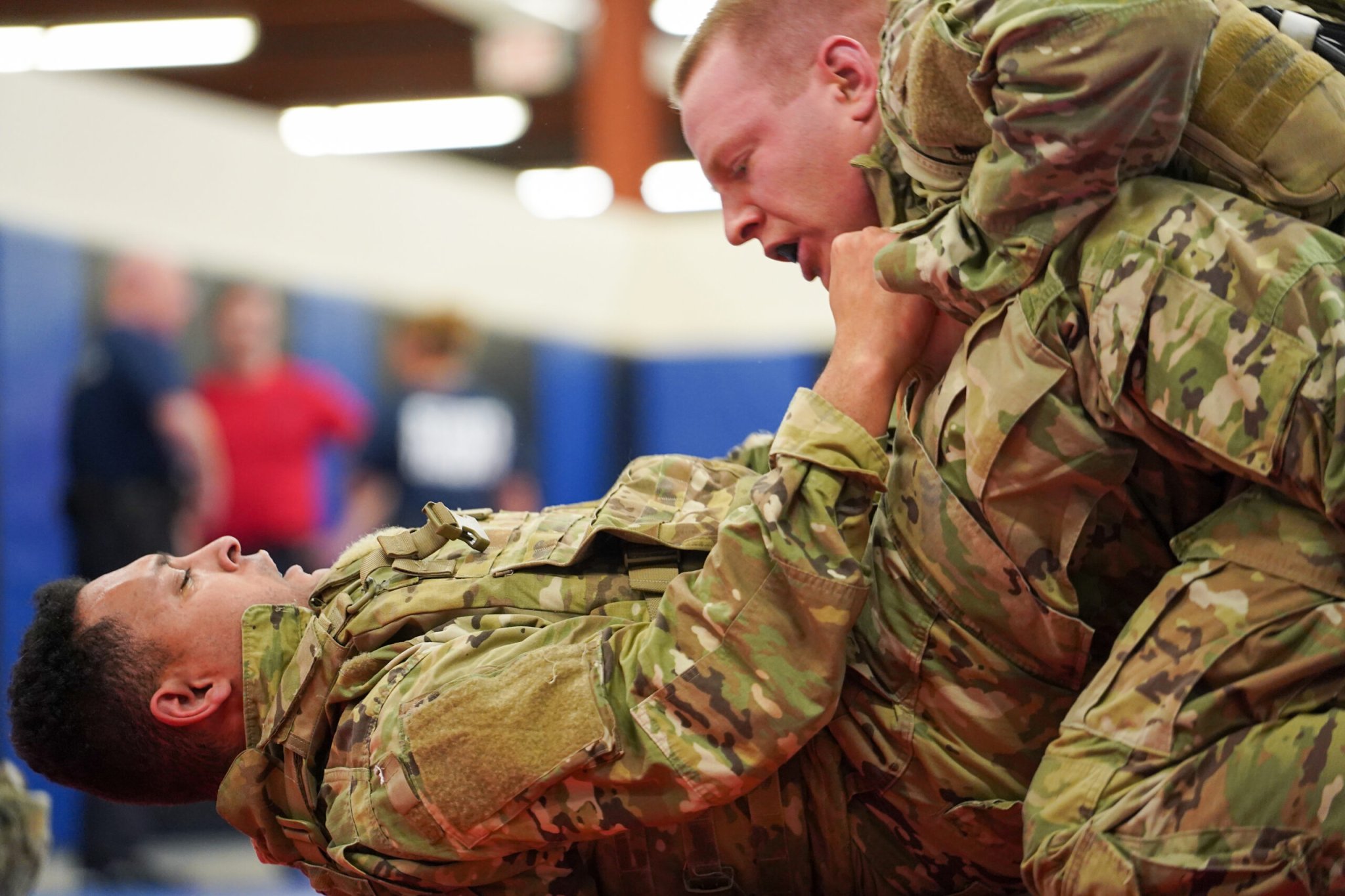

When clearing through a room, a soldier is always at risk of hand-to-hand combat, though it can happen on the open battlefield, too. The Modern Army Combatives Program (MACP) is one of the building blocks for soldiers which enables them to defend themselves and gain physical control over anyone who threatens them.
Sgt. 1st Class Zach Rapada, Branch Chief of the U.S. Army Combatives Course, has been involved in teaching combatives to his fellow soldiers since he enlisted in 2012. Though MACP basics will establish a foundation in combatives, it does not make a soldier a professional UFC fighter.
“They are not comparable,” Rapada said. “[MACP] gets soldiers the basics; it’s up to them to advance their skills at their units or during off hours.”
It’s a combatives program with various training levels, in which the student can become the teacher as they progress through the training. The certifications alone won’t make a soldier an unstoppable powerhouse, but it’s a vast improvement compared to the military’s early forms of combatives.
A brief history of the Modern Army Combatives Program
The first combatives manual, translated from a French bayonet fighting manual, was adopted by the U.S. military in 1852. However, World War I proved that this style of bayonet fighting was ineffective in the narrow trenches.
Later, during World War II, U.S. Army Col. Rex Applegate, British Royal Marine Lt. Col. William Ewart Fairbairn, and British Army Capt. Eric Sykes created a hand-to-hand combat methodology based on simplified lessons learned from the battlefield, which later became “the evolutionary foundation of MACP.”
After WWII, combatives training became watered down according to soldiers who had some sort of traditional martial arts experience. FM 21-150 became the default field manual explaining combatives and remained the standard into the early 1990s. However, the 2nd Battalion, 75th Ranger Regiment exposed flaws in the training and formed a research committee that eventually created MACP Levels 1 to 4.
Subscribe to Task & Purpose today. Get the latest military news and culture in your inbox daily.
Then, in 2002, the first “Army-wide Modern Army Combatives Manual, FM 3-25.150,” was published, and soldiers began training the updated combatives. The latest field manual is continually updated based on lessons learned on the battlefield and exposure to more effective fighting styles.
The latest updates occurred in 2014 when the Combatives Master Trainer Course replaced both Levels 3 and 4 and updated Levels 1 and 2.
MACP Levels 1, 2, and 3
The Army Combatives Course is based at Ft. Moore, Georgia, and falls under the 1st Battalion, 29th Infantry. But all soldiers attend a Level 1 Basic Combatives course during basic training.
The drill sergeants, who are either MACP Level 2 or 3 certified, teach the new soldiers how to respond to an enemy rapidly closing distance. They’ll learn things like how to pass guard, place someone in a rear naked choke, or defend against knee strikes in a clinch.
“They build confidence quickly when someone bigger than them is coming at them, punching and kicking,” Rapada said.
Soldiers can later attend the MACP Level 2 Tactical Combatives Course training, where they will learn to master the basics as a trainer of Level 1 MACP.
The major difference between Level 2 and the CMTC is that trainers learn how to set up and referee combatives tournaments. But even as a Combatives Master Trainer, that doesn’t make a soldier qualified to take on someone like Connor McGregor.
Rapada said to be a respected trainer, a soldier must continue to hone their craft by attending more advanced martial arts classes like Jiu-Jitsu, Krav Maga, and mixed martial arts.
“Why would anyone listen to an instructor that a student beat up,” Rapada said.
He joined the military as a brown belt in Jiu-Jitsu and was selected early on to be a trainer due to his performance in the Level 1 Basic Combatives course. Rapada has helped establish training gyms at different units during his tenure and is always looking to better himself as a practitioner and trainer.
He’s since progressed to being a master trainer and has attended Levels 1 and 2 of the Special Operations Combatives Course, which teaches soldiers how to disarm an armed enemy, fighting in full combat gear, and many other more advanced fighting techniques.
But an important aspect for anyone who starts their combatives journey is there is always something new you can learn, and there is almost always someone better than you. So whether you earned your Level 1 or you become a Master Trainer, don’t go picking fights.
The latest on Task & Purpose
- 82nd Airborne paratroopers cut down a 101st flag from an iconic bar on D-Day
- Navy fires USS Somerset’s commanding officer following investigation
- Two ex-U.S. soldiers met in Ukraine, then went on ‘international crime spree’
- A combat controller earned a secret Air Force Cross for battle with Russian mercenaries
- Fort Moore renames five gates for battlefield heroes like Alwyn Cashe
